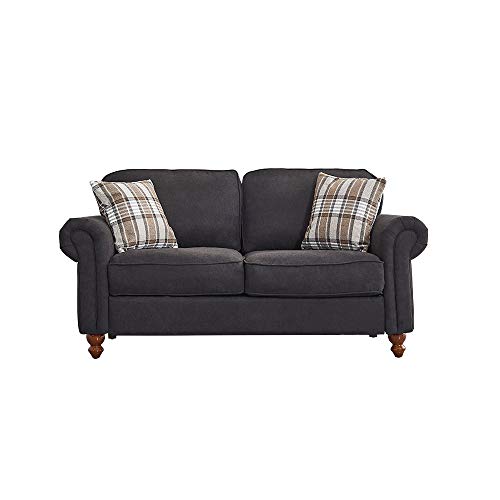Guide To 2 Seater Leather And Fabric Sofa: The Intermediate Guide The …
페이지 정보

본문
 Choosing Between a 2 Seater Leather and Fabric Sofa
Choosing Between a 2 Seater Leather and Fabric SofaIt can be difficult to choose between leather and 2 seater fabric sofa uk when you are looking for a new couch. This is especially the case if you're not a professional with knowledge of furniture.
 If you have children or live in a small space, a leather option could be best for you. It is easy to maintain and looks gorgeous in most homes.
If you have children or live in a small space, a leather option could be best for you. It is easy to maintain and looks gorgeous in most homes.Comfort
The sofa is typically the focal point in many homes and is a significant purchase. You want a sofa that can be used for a long time and that looks good and will stand the test of time. It isn't easy to choose between fabric and leather and fabric 2 seater sofa, but you must consider your lifestyle, budget and other priorities before making a choice.
Leather is a high-end, luxurious material that exudes class and luxury in any home. It is strong and stain-resistant, as well as insensitive to pets and children, and will last for a long time with proper maintenance. It is expensive up front and may need regular conditioning to prevent cracks or peeling.
fabric two seater sofa sofas come in a wide range of styles, colors and fabrics. They are a more affordable choice than leather sofas. They are also softer, more welcoming and can be "broken in" right from the beginning. They may be more susceptible to dust mites and pet hairs and require frequent cleaning. However, thanks to advances in technologies and performance fabrics, there are now hypoallergenic alternatives available.
The durability of a sofa made of fabric 2 seater sofa will depend on the quality of the material However, the majority of fabrics can expect to last for 15 years if they are properly taken care of. Regular vacuuming and deep-cleaning will ensure that the 2 seater fabric is free of odours, stains and dirt. Like leather, they are susceptible to flattening and sagging over time. A majority of couches made of fabric are treated with chemicals that make them stain resistant and flame-resistant. These can release volatile organic compounds that could affect the quality of air in the indoor environment and cause allergies.
Durability
When purchasing sofas, we usually select fabrics that are extremely durable because this can be important for those with pets and children. You don't want to invest a lot upfront and end up with buyer's remorse after the first spill or claws that are crowbarred. Also you don't want to purchase a product that isn't expensive but can't withstand regular use.
Leather, however, is extremely resilient and has an incredible strength for tears. It can last up four times longer than fabric and is innately resistant against cracking, fading, and flaking. It can be conditioned to replenish its natural oils and to make it appear new.
Fabrics are less expensive and come in a variety of colors, patterns and textures that can be adapted to any design scheme. They are also cleaner than leather and can withstand a fair amount of wear and tear, but they do tend to be more prone to moisture and fade over time.
Microfiber is tough and comes in a variety of colors. However, it may not be as durable as genuine leather. It might also not be able to take scratches. However, it's still an excellent choice for families due to of its resilience to stains and spills and it is easy to clean generally with a damp cloth.
Suede is more difficult to clean and repair than leather. It is also prone to losing its shape if not regularly conditioned and can feel quite rough to the touch. It is also a thin product, so it might not be as durable as sheepskin and cowhide leather.
Allergens
The material your sofa is made from can have a big impact on your allergies, which is why it's crucial to know the various options that are available. Fabrics tends to retain allergens, such as dust mites and pet dander, which can trigger symptoms such as asthma, hay fever, rhinitis and eczema. These fabrics are ideal for them to thrive.
Leather on the other hand isn't susceptible to the accumulation of allergens and provides constant comfort regardless of the season. It can also cause dermatitis in people who have contact dermatitis or are allergic to the chemicals used in tanning. To prevent skin reactions, it is essential to use products that are vegetable-tanned and keep a consistent routine for your skin.
Both sofas made of fabric and leather are durable, but the material you choose will have a significant impact on how well your couch is able to stand up to wear. A top-quality fabric will stand up to daily usage without fading or sagging and will endure spills and body oils with ease. Many modern couches come with stain-resistant treatment to make cleaning simpler.
While you might not be able to completely stop an allergic reaction from the leather on your sofa, you can help to prevent allergens from forming by having a lint roll near and regularly vacuuming your living area. This can help reduce the amount of dirt, pet hair and dust mites that build up on your sofa. If you are still suffering from allergies, try replacing your sofa for a more hypoallergenic version. For example, a sofa made of synthetic or vinyl will be less likely to hold dust and pet mites. It will also help you breathe better.
Scratches
When purchasing a leather sofa, it is important to think about how much wear and tear you can expect from it. The color, finish and quality of the leather are crucial elements in determining how long a sofa will last. It is also important to ensure that the couch is strong enough to withstand spills and other accidents. This can be achieved by selecting a sofa with a solid wood frame and high density foam cushions.
Leather can be damaged due to various reasons such as stretching it, marking territory or reliving tension. Scratches can be of various severity. They vary from minor surface scratches to deep punctures or cuts. Small scratches can be fixed by applying a conditioner for leather to the area affected. This will help restore the equilibrium of moisture and oil in the leather, which will prevent drying out and cracking. The extent of damage will determine the type of treatment needed.
It is recommended for cat owners to trim their cat's nails on a regular basis. This will stop them from scratching the sofa. You can also stop the scratching behavior by providing them with alternative scratching surfaces like sisal rope or cardboard. You can also apply a pet-safe furniture polish which you can apply using an easy, clean cloth.
It is important to wash your leather couch frequently and keep it away from heat and direct sunlight, because they dry it out. This could cause it to crack and become difficult to repair and frequently requires the reupholstery. Use a conditioner for leather as well to keep the leather soft.
Smell
A leather sofa is likely to have a different smell than fabric. It's because leather is porous, and will absorb odors like smoke, body odors or food. The good thing is that odors usually dissipate with time particularly when you use a nontoxic and fragrance-free cleaner.
If the smell is overwhelming it could indicate that something is wrong with the foam. This is usually caused by the chemical off-gassing that occurs in polyurethane based on petroleum. If you're worried about this, look for couches made of CertiPUR US certified latex foams or natural latex.
A second way to identify faux leather is to feel for bumps or a texture on the back of the sofa. This indicates that the leather is not authentic top grain. You can also conduct an inspection of the interior by tilting the couch on its side to check if you see any upholstery backing that is visible. If you smell it, it's likely a synthetic material like polyester or polyurethane. These materials will have a different scent than leather.
While a leather couch is more prone to picking up smells, the best way to avoid this is to regularly clean your sofa. This will keep it looking great and smelling good and will also stop it from becoming stiff or brittle over time. Begin by vacuuming and dusting the couch and then wiping it clean with a dry cloth and baking soda (a excellent natural method to get rid of odors). You should do this at least once every two weeks or more to rid your sofa of dust and dirt accumulation. Then apply a leather conditioner to help keep your sofa's color and texture.
- 이전글What's The Job Market For Wall Mounted Electric Fireplace With Mantel Professionals Like? 24.11.23
- 다음글The key Of Explore Daycares Locations 24.11.23
댓글목록
등록된 댓글이 없습니다.




